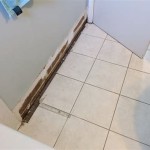Labor Cost to Replace a Bathroom Vanity: A Comprehensive Guide
Replacing a bathroom vanity can significantly improve the aesthetics and functionality of a bathroom. However, understanding the associated labor costs is crucial for budgeting and planning. The cost of labor to replace a bathroom vanity can vary significantly based on numerous factors, including the complexity of the installation, the existing plumbing, the location of the residence, and the selected contractor. This article provides a comprehensive overview of the elements that influence the labor cost of a bathroom vanity replacement project.
The labor cost typically encompasses the time and effort required to remove the old vanity, prepare the space, install the new vanity, connect the plumbing, and address any unforeseen issues that may arise during the process. It is important to note that the cost of the vanity itself is separate and should be factored into the overall project budget.
Factors Influencing Labor Costs
Several factors contribute to the overall labor cost of replacing a bathroom vanity. Understanding these factors will help homeowners obtain accurate estimates and avoid unexpected expenses.
Complexity of Installation: The complexity of the installation is a primary driver of labor costs. A simple, like-for-like replacement, where the new vanity is the same size and configuration as the old one and the plumbing remains unchanged, will typically be less expensive than a more complex installation. Complexities arise when alterations to the plumbing are necessary, such as moving drain lines or water supply lines. Similarly, if the new vanity is a different size, modifications to the flooring or wall may be required, increasing the labor time and associated costs. Custom vanities, due to their unique nature, often require more meticulous installation procedures and may necessitate specialized skills, further elevating the labor expenses.
Existing Plumbing Infrastructure: The condition and configuration of the existing plumbing also significantly impact labor costs. Older homes, in particular, may have outdated plumbing materials such as galvanized steel or lead pipes, which can be more difficult to work with and may require replacement or upgrades to meet current codes. Corrosion, leaks, or other plumbing issues discovered during the removal of the old vanity can necessitate unexpected repairs, adding to the overall labor cost. If the drain lines or water supply lines are not properly aligned with the new vanity, the plumber will need to modify them, which can involve cutting, soldering, and rerouting pipes. The more extensive the plumbing modifications, the higher the labor cost.
Location and Accessibility: The location of the bathroom within the home and its accessibility can also influence labor costs. Bathrooms located on upper floors or in basements may be more difficult to access, requiring additional time and effort to transport materials and equipment. Tight spaces within the bathroom can also impede the installation process, slowing down the work and increasing the labor hours. If the bathroom is difficult to access or navigate, the contractor may need to take extra precautions to protect surrounding areas from damage, which can also contribute to the overall cost.
Contractor's Rates and Experience: Different contractors have different rates, reflecting their experience, expertise, and overhead costs. Licensed and insured plumbers and contractors typically charge higher rates than unlicensed handymen, but they also offer greater assurance of quality workmanship and compliance with building codes. A contractor with extensive experience in bathroom renovations will be more efficient and knowledgeable, potentially completing the project faster and with fewer errors than a less experienced contractor. Obtaining multiple quotes from different contractors and comparing their rates, qualifications, and references is essential to ensure a fair price and a satisfactory outcome.
Demolition and Removal: The process of removing the existing vanity can also contribute to labor costs. Disconnecting the plumbing, detaching the vanity from the wall, and disposing of the old vanity require time and effort. If the old vanity is heavily damaged or difficult to remove, it may take longer and require specialized tools or techniques. The contractor may also need to patch and repair any holes or damage to the wall or flooring after the old vanity has been removed. Hauling away the debris and properly disposing of it can also add to the overall labor cost, depending on the contractor's policies and local disposal fees.
Unexpected Issues and Repairs: During the vanity replacement process, unforeseen issues may arise that can impact labor costs. These issues can include hidden water damage, mold growth, or structural problems that require repair before the new vanity can be installed. Discovering such problems can add significant time and expense to the project, as the contractor may need to address the underlying issues before proceeding with the installation. It's advisable to have a contingency budget in place to cover any unexpected repairs or modifications that may be necessary.
Typical Labor Cost Breakdown
To provide a clearer understanding of the labor costs involved in replacing a bathroom vanity, a typical breakdown of the various tasks and their associated expenses is presented below. These figures are estimates and can vary depending on the factors discussed earlier.
Removal of Old Vanity: This typically involves disconnecting the plumbing, detaching the vanity from the wall, and removing the old unit. The cost can range from $50 to $150, depending on the size and complexity of the vanity, as well as the condition of the plumbing connections. Older plumbing may require extra care to avoid damage and potential leaks.
Preparation of the Space: This includes cleaning the area, patching any holes or damage to the wall or flooring, and ensuring that the space is level and ready for the new vanity. The cost can range from $50 to $100, depending on the extent of the repairs needed. This stage is crucial to ensure a proper and secure installation of the new vanity.
Installation of New Vanity: This involves mounting the new vanity to the wall or floor, ensuring that it is level and secure. The cost can range from $150 to $400 depending on the size, complexity, and whether the vanity is pre-assembled or requires assembly. Custom or more elaborate vanities will generally be on the higher end of this range.
Plumbing Connections: This includes connecting the water supply lines and drain lines to the new vanity. The cost can range from $100 to $300, depending on the complexity of the plumbing connections and whether any modifications are needed. This step requires a skilled plumber to ensure that all connections are properly sealed and leak-free.
Final Adjustments and Cleanup: This involves making any final adjustments to the vanity, such as leveling the doors and drawers, and cleaning up the work area. The cost can range from $50 to $100. This ensures that the vanity is functioning properly and that the bathroom is left clean and tidy.
Based on these estimates, the total labor cost for replacing a bathroom vanity can range from $350 to $950. However, it is important to remember that these are just estimates, and the actual cost may vary depending on the specific circumstances of each project. Additional costs may be incurred for unexpected repairs, plumbing modifications, or other unforeseen issues.
Tips for Managing Labor Costs
Homeowners can take several steps to manage the labor costs associated with replacing a bathroom vanity. These tips can help to reduce expenses and ensure a smooth and cost-effective installation.
Obtain Multiple Quotes: Getting quotes from at least three different contractors is essential to compare rates and services. When requesting quotes, provide contractors with as much detail as possible about the project, including the size and type of vanity being installed, the condition of the existing plumbing, and any specific concerns or challenges. This will help contractors provide more accurate estimates. Review each quote carefully, paying attention to the scope of work, the materials included, and the payment schedule.
Choose the Right Contractor: Select a licensed and insured contractor with experience in bathroom renovations. Verify that the contractor has the necessary qualifications and insurance coverage to protect yourself from liability in case of accidents or damages. Check online reviews and ask for references from previous clients to assess the contractor's reputation and quality of work. A reputable contractor will be transparent about their pricing and will be willing to answer any questions you may have.
Prepare the Space: To minimize labor costs, prepare the bathroom as much as possible before the contractor arrives. This can include clearing out any personal items, removing any obstacles that may impede access to the work area, and protecting the flooring and walls from damage. If possible, disconnect the water supply to the old vanity and remove any remaining water from the drain lines. This will save the contractor time and effort, potentially reducing the overall labor cost.
Consider DIY Assistance: Depending on your skill level and comfort level, you may be able to assist the contractor with certain tasks, such as removing the old vanity or cleaning up the work area. However, it is important to be cautious and avoid attempting tasks that require specialized skills or knowledge, such as plumbing or electrical work. Misguided DIY efforts can lead to costly mistakes and potentially dangerous situations. Consult with the contractor before offering assistance to ensure that it is appropriate and helpful.
Plan Ahead and Be Flexible: Plan the vanity replacement project carefully, taking into account all the factors discussed earlier. Be flexible and prepared to address any unexpected issues or challenges that may arise during the process. Maintaining open communication with the contractor and being responsive to their needs will help to ensure a smooth and efficient installation. Having a contingency budget in place will provide peace of mind and allow you to address any unforeseen expenses without derailing the project.
In conclusion, determining the labor cost to replace a bathroom vanity involves considering a multitude of factors. By understanding the elements that influence these costs and taking proactive steps to manage them, homeowners can make informed decisions and ensure a successful and budget-friendly bathroom renovation.

Bathroom Vanity Installation Cost 2024 Average S

Cost To Replace Bathroom Vanity Evaluating Expenses

Cost To Replace Bathroom Vanity Evaluating Expenses

How Much Does Bathroom Vanity Installation Cost 2025

Bathroom Sink Cost To Replace Fixr

Cost To Replace Bathroom Vanity Evaluating Expenses

How Much Does It Cost To Replace Bathroom Countertops Angi

Cost To Replace Bathroom Vanity Evaluating Expenses

How Much Does Bathroom Vanity Installation Cost 2025

How Much Does Bathroom Vanity Installation Cost Angi
Related Posts







